A Cat in Paris (‘Une Vie de Chat’, 2010) is a charmingly funny, aesthetically beautiful and surprisingly thrilling French animated film, directed by Alain Gagnol and Jean-Loup Felicioli. [1] The film tells the story of Dino, a Parisian cat who leads a double life. By day he is a comforting and playful pet to a young mute girl called Zoe but when night falls he is the accomplice to the stealthy and sly but warm-hearted cat burglar, Nico. Zoe’s mother is a superintendent assigned to the case of the cat burglar whilst also searching for her husband’s murderer, the comically evil gangster, Victor Costa. When Zoe follows Dino out one night, worlds start colliding as she stumbles upon the revelation that her nanny, Claudine, is in cahoots with Costa. The film culminates in a dramatic chase sequence across the Parisian skyline and atop Notre-Dame, with Costa losing a grip on his sanity and falling to his death.
Despite its contemporary production and release date, A Cat in Paris has a relatively unique and retro style of animation. Felicioli has stated in an interview how he originally ‘wanted to be a painter’ before becoming an animator. [2] This is certainly apparent in the style of the drawings, which are much more reminiscent of Picasso or Modigliani than any Disney film. Characters are disproportionately sized, perspective is warped, and characters and the cat leap unfathomable distances across the rooftops (see fig. 1).
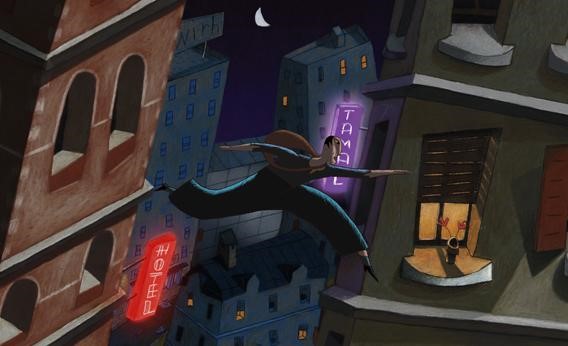
A.O. Scott has praised this aspect of the film’s aesthetic: ‘The laws of physics are brazenly flouted as Mr. Felicioli and Mr. Gagnol take splendid advantage of the freedom that animation can offer to the hand, to the eye and the imagination’. [3] Indeed, it is through this physics-bending that much of the film’s entertainment feeds off, particularly when depicting the stealthy, rubbery movements of Nico. Moreover, the film contains all the romance and suspense of a classic noir thriller but presents it through the warped perspective of a Cubist painting. This stylistic cocktail engenders innovative scenes such as when Nico and Dino creep through the darkness to save Zoe. In addition, beneath the veneer of threatening violence, the gangsters’ idiocy also provides some of the funnier and more farcical moments in the film. It is the application of such a unique animated style to a narrative that shifts between Hitchcockian thriller, crime caper comedy, and touching family drama that makes the film most endearing.
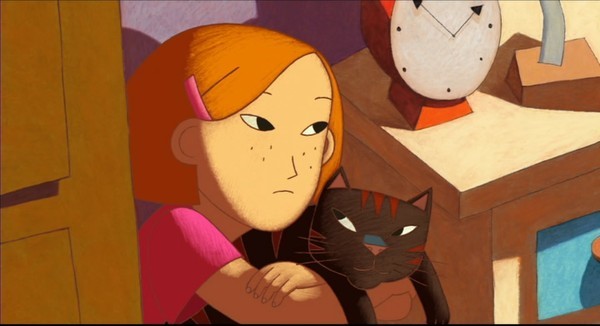
As the title indicates, Dino the cat is the most significant animal presence in the film, particularly due to his secretive, double life. He provides comfort and care for the mute, lonely and fatherless Zoe. When the audience are introduced to Zoe, Dino brings her a lizard he has just caught on the roof. As she puts it in a box full of other lizards, we see that this is a regular occurrence and it immediately signals the human-pet bond between Zoe and Dino. Due to both Zoe’s and Dino’s inability to talk, their relationship is expressed through images, actions and bodily language in the animated format. For example, when Zoe runs to her room, upset that her mother is too busy to talk to her, Dino crawls up to her and squirms his way into her arms, purring softly as he does so (see fig. 2). It is an image of affection that demonstrates Dino’s emotional capacity to understand when Zoe is upset. Moreover, Dino is even able to act on these emotions, comforting and caring for her through an embrace.
The representation of Dino is most interesting, however, when he is Nico’s accomplice. With an obvious pun on the notion of a “cat-burglar”, Nico and Dino stylishly and stealthily steal expensive jewellery. They bound effortlessly and silently across rooftops and through windows, with the Cubist animation beautifully bending and contorting their bodies like elastic. Not only does Dino accompany Nico, but he proves to be vital to Nico’s success. On occasions, Dino enters a window, surveys the room, and meows to Nico as a signal to tell him that it is clear and safe.
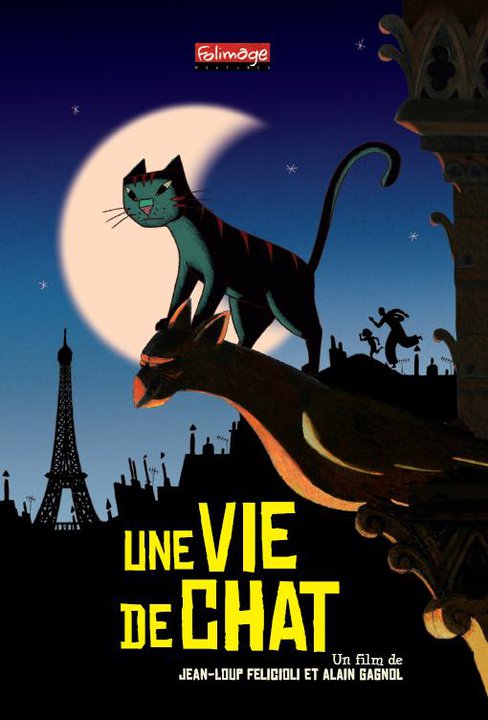
Further, A Cat’s Life marks a departure from popular animated animal narratives in which animals are depicted anthropomorphically, with human speech and cognitive faculties. Conversely, throughout the film, Nico frequently embodies characteristics of the cat in order to be a successful “cat-burglar”. For example, when Nico climbs up a tree and onto a wall, Dino follows by jumping straight up onto the wall. Nico laughs and calls him a ‘show-off’. When moving secretively, climbing into hard-to-reach places, Dino the cat is able to do so quicker
and easier. This is most explicit later in the film when Dino and Nico are trying to find Zoe after she has been kidnapped by Claudine, Victor and the gangsters. As they stand on a roof, with Nico thinking what to do, Dino catches the scent of Claudine’s perfume (see fig. 3). Until this point in the narrative, the perfume has been a running gag in which the cat sneezes every time Claudine enters smelling like she does. As she sprays it onto her neck in the prior scene, the animation visualises the smell as a thick purple cloud. The cloud leaves the room and into the street, with Claudine’s face drawn into the cloud like an evil spirit. By visualising the smell in this way, the animated format represents the cat’s heightened and specific sensory perception. Further, the symbolic depiction of Claudine’s face in the cloud cinematically conveys Dino’s association of the perfume with Claudine. When the cloud reaches Nico and Dino, only Dino is able to smell it. The clue to Zoe’s whereabouts is gathered only by the cat because of his specific animality.
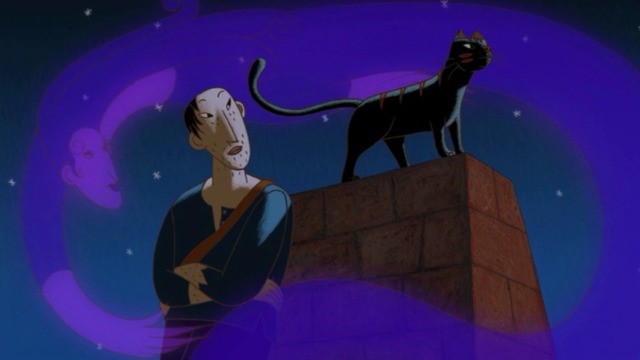
As Nico and Dino follow the scent to save Zoe, the film increasingly explores the generic conventions of a thriller. Employing his cat-burglary skills, Nico cuts the power to the building so he and Dino can sneak in past the gangsters. As he puts on a pair of night-vision goggles, he says: ‘I’m like you now, Cat. I can see in the dark’. Again, in order to achieve his aim, Nico has to become cat-like, with technology that allows him to see in the dark. As with the visualised perfume smell, the animated format artistically represents the altered sensory perceptions of the cat and Nico. Removing colour from the screen, all characters are now only seen as white outlines on black (see fig. 4). It is an innovative but strikingly simple rendering of the capacity to see in the dark. As they slip undetected through the house, Dino jumps into Zoe’s arms in exactly the same way he comforted her earlier in the film. The importance of Zoe and Dino’s non-verbal communication is most emotionally touching and fitting here. Without giving any sign to her captors, Dino is able to communicate to Zoe that he and Nico are saving her simply through the sensation of touch.
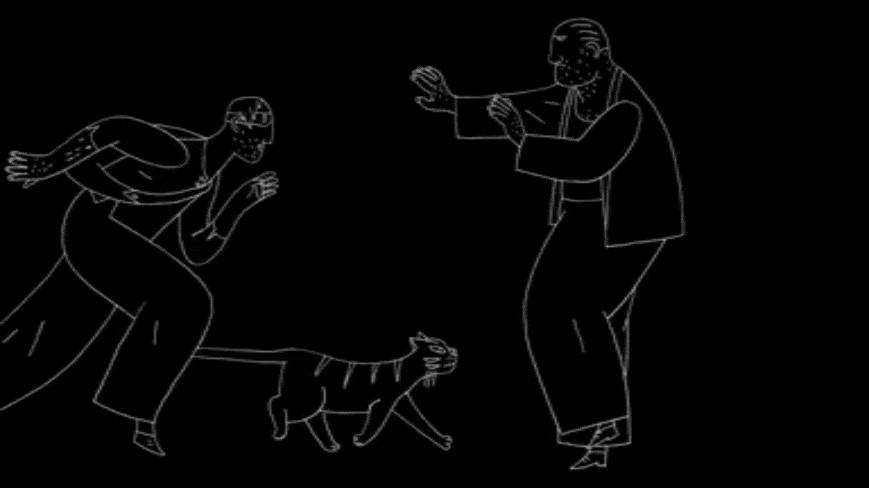
Dino’s skills prove fundamental to the development of the plot, particularly in the way he is able to help, save and protect other human characters. He is able to lead Zoe to Nico’s apartment, somehow aware of the danger she is in and only attacks the characters who are enemies to Zoe and Nico. He displays a preternatural consciousness toward the world around him, often indicated through the specific movements and expressions of his face. For example, in multiple scenes, there are multiple cuts to Dino’s face as he sleeps or watches carefully with one eye open. The use of editing creates a subjective point-of-view from the cat’s perspective and thus characterises the cat as being not only intelligent, but particularly acute to humans’ interactions and emotions. The most obscure, humorous and outlandish example of this happens when Costa falls from the heights of Notre-Dame. Nico, Zoe and Jeanne all cry out, look shocked or look away as he falls. In one quick cut, however, we see the cat smiles as he watches Costa fall. Through a delightfully dark joke, the cat expresses the emotion the characters and audience desire to express on seeing the cartoonish villain come to an end.
A Cat’s Life is reminiscent of Belleville-Rendezvous, not least for its quirky French humour and expressionistic aesthetic, but also for its depiction of the lives of pets in urban areas. One running joke, in which a dog barks at passing trains, is very similar to the multiple scenes in which a dog barks at Dino as he passes. Further, cats frequently appear as pets in films, from Kiki’s Delivery Service to Breakfast to Tiffany’s, often providing emotional and practical help like Dino.
[1] A Cat In Paris. Dir. Alain Gagnol and Jean-Loup Feliocioli. Gebeka Films. 2010.
[2] Jean-Loup Felicioli, ‘Interrogation Room No.1’, trans. by Dave Jesteadt, A Cat In Paris: Discover The Film, <http://www.catinparis.com/> [accessed 19 January 2016] (para. 4).
[3] A.O. Scott, ‘Ignoring Laws of Physics as They Run Across Roofs: “A Cat In Paris” Review’, in The New York Times (2012) <http://www.nytimes.com/2012/06/01/movies/a-cat-in-paris-the-animated-french-film.html> (para.2 of 10).